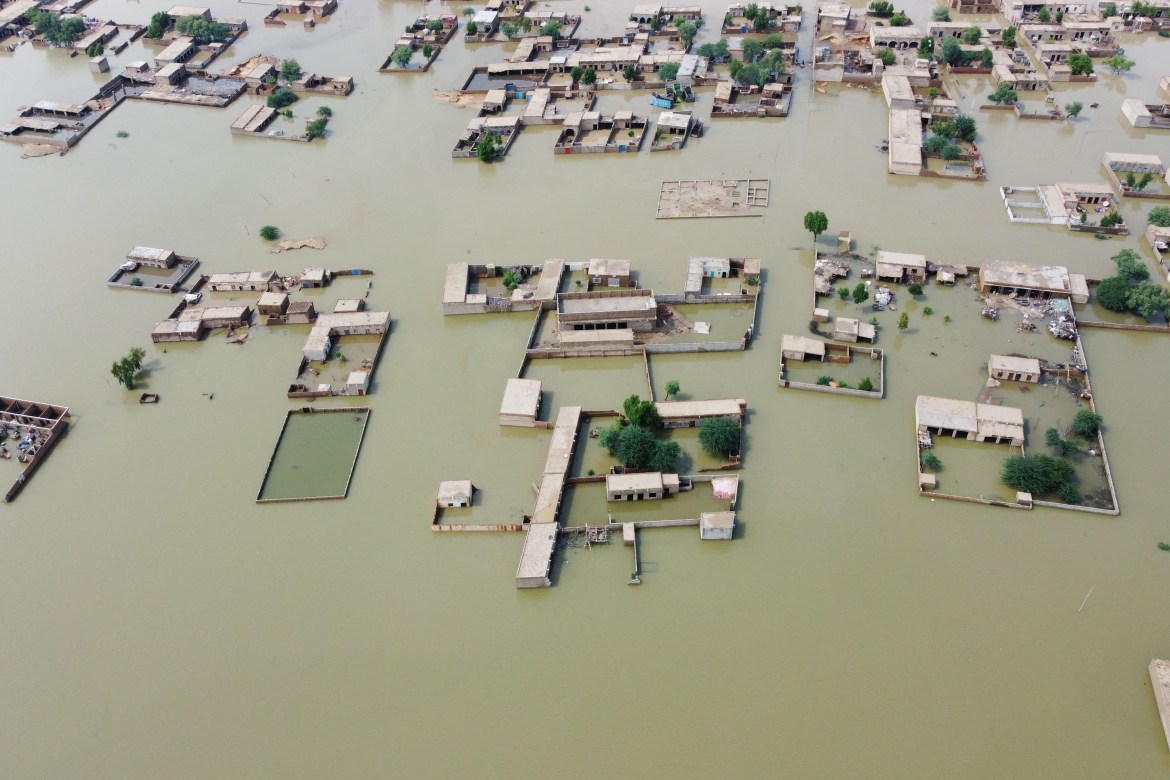
Flood in Pakistan affects many villages and leave families homeless. Devastating monsoon rains have caused the worst floods in Pakistan in 2022. Affected villages and some 34 million children need aid. Currently, it increases the risk of water-borne diseases, drowning, and malnutrition.
Disastrous Situation
Now, millions of homes have been destroyed, while many public health facilities, water systems, and schools have been destroyed or damaged. As of September 9, more than 664,000 people were sheltering in displacement camps, many without adequate shelter and access to adequate food, clean water, and sanitation.
UNICEF is responding with the government and partners, helping to provide clean drinking water. life-saving medical equipment; supply of therapeutic food; and hygiene kits for children and families. We are also setting up temporary education centers and supporting the protection and psychological well-being of children affected by these devastating floods. But much more is needed to ensure that we can reach all the families displaced by the floods and help them overcome this climate disaster. 1/3rd of the country is under water after a severe heat wave and prolonged monsoon have wasted record amounts of rain.
Causes:
With rivers breaking their banks, flash floods, and glacial lakes bursting, Pakistan is facing its worst floods of the century. At least 1/3rd of the country is underwater. Scientists say many factors contributed to the extreme event, which displaced nearly 33.5 million people and killed more than1300.Researchers say the catastrophe was probably triggered by unusual heat waves. In April, May, and June temperatures reached above 42 °C for extended periods at many places. On a hot day in May, the temperature in Jacobabad city reached 52 degrees Celsius. “These were no ordinary heat waves – these were the worst in the world. We had the hottest place on earth in Pakistan.
WARM AIR
Warm air can hold more moisture. So, meteorologists warned earlier this year that extreme temperatures could result in “above normal” levels of rainfall in the country’s monsoon season from July to September.
MELTING GLACIERS
Athar Hussain, a climate scientist says the intense heat also melted glaciers in the northern highlands, increasing the amount of water flowing into tributaries that eventually flow into the Indus River. The Indus River, Pakistan’s largest river, runs the length of the country from north to south, consuming large swaths of cities, towns, and agricultural land along the way. It’s not clear exactly how much snowmelt has drained the rivers this year but Hashmi visited some high-altitude snowfields in July and saw high flows and muddy water in the Hunza River, which flows into the Indus. They say the mud shows rapid melting, as fast water picks up sediment as it moves downstream. Many glacial lakes have burst from the ice dams that normally hold them back, releasing dangerous rushes of water.
The heat waves also coincided with another unusual event – a depression, or severe low-pressure system in the Arabian Sea, that brought heavy rains to Pakistan’s coastal provinces in early June. “We rarely have large-scale depression systems,” Hussain says.
HEAT WAVES
HARVESTING
Harvesting is often cited as a cause of floods, but the role of the timber mafia in Pakistan appears to be a significant factor. Despite only 5.2 percent of the land being covered, the denudation caused by illegal logging contributes to flood damage. Reports suggest that during the Pakistani Taliban’s control from 2007 to 2009, 70 percent of forests in parts of Malakand Agency, Khyber Pakhtunkhwa, were illegally cut down. The Guardian highlights the severity of flooding in areas where the timber mafia operates, emphasizing how uprooted trees, initially planted for smuggling, exacerbate the destruction. These findings underscore the critical link between deforestation, criminal activities, and the increased risk of flooding in Pakistan.

MOONSOON SEASON
The unusual features were compounded by the early arrival of the monsoon. Generally wet over a large area for a very long period. The effect is that Pakistan has so far received an average of annual rainfall during the monsoon period. The southern provinces of Sindh and Balochistan have recovered five times more than the average. Some weather agencies also predict that the ongoing weather event — a phenomenon typically associated with strong monsoon conditions in India and Pakistan — will continue through the end of the year.
GLOBAL WARMING
Human-induced global warming can also intensify rainfall. Hussain says climate models suggest a warmer world will contribute to more intense rainfall. Between 1986 and 2015, temperatures in Pakistan increased by 0.3 °C per decade, which is higher than the global average.
RESEARCH
Researchers also say other factors contributed to the disaster, including an ineffective early flood warning, poor management, and unplanned development. Lack of drainage and storage infrastructure, the large number of people living in flood-prone areas, are also implicated. “These are governance issues, but they are minor about the level of tragedy that we are seeing unfold.

REPORT
Down south, Indus resonates with a similar story. While, villagers and local people have been resisting land grabs against landlords and the military, the state response has been almost blunt. According to available facts, forests cover only 2.3% of Sindh's total area and reports claim that the deteriorating condition of forests prevents them from contributing timber, fuelwood, or fodder. There are continuous reports in the media that large-scale illegal felling of trees is taking place along the banks of canals and riverine forests in northern Sindh. The timber mafia, whose operations often go unchecked due to their links with the political leadership of northern Sindh, are accused of upsetting the delicate balance of the ecosystem.
HOW TO GET RID OF FLOOD
The average homeowner has three methods of removing floodwaters.
1: with a shop vacancy.
2: with a water pump designed to draw in water.
3: with the hand buckets and containers.
When using a shop vacuum, the filter may need to be removed before use to suck up flood water.
If you want to read more articles click here










![How to apply and get Digital Franchise Post Office? Submit your application for Digital Franchise Post Office by Pakistan Post via [youngstars.pk]](https://youngstars.pk/wp-content/uploads/2020/08/How-to-apply-and-get-Digital-Franchise-Post-Office-by-Pakistan-Post-youngstars.pk_-218x150.png)




… [Trackback]
[…] Find More to that Topic: youngstars.pk/2022/12/2180/flood-in-pakistan-2022-aftershocks-continues/ […]
… [Trackback]
[…] Info on that Topic: youngstars.pk/2022/12/2180/flood-in-pakistan-2022-aftershocks-continues/ […]
… [Trackback]
[…] Find More here on that Topic: youngstars.pk/2022/12/2180/flood-in-pakistan-2022-aftershocks-continues/ […]
… [Trackback]
[…] Find More to that Topic: youngstars.pk/2022/12/2180/flood-in-pakistan-2022-aftershocks-continues/ […]
… [Trackback]
[…] There you will find 43520 more Info on that Topic: youngstars.pk/2022/12/2180/flood-in-pakistan-2022-aftershocks-continues/ […]
… [Trackback]
[…] Read More to that Topic: youngstars.pk/2022/12/2180/flood-in-pakistan-2022-aftershocks-continues/ […]
… [Trackback]
[…] Read More on that Topic: youngstars.pk/2022/12/2180/flood-in-pakistan-2022-aftershocks-continues/ […]
… [Trackback]
[…] Information on that Topic: youngstars.pk/2022/12/2180/flood-in-pakistan-2022-aftershocks-continues/ […]
… [Trackback]
[…] Info to that Topic: youngstars.pk/2022/12/2180/flood-in-pakistan-2022-aftershocks-continues/ […]
… [Trackback]
[…] Read More on that Topic: youngstars.pk/2022/12/2180/flood-in-pakistan-2022-aftershocks-continues/ […]
… [Trackback]
[…] Find More here on that Topic: youngstars.pk/2022/12/2180/flood-in-pakistan-2022-aftershocks-continues/ […]